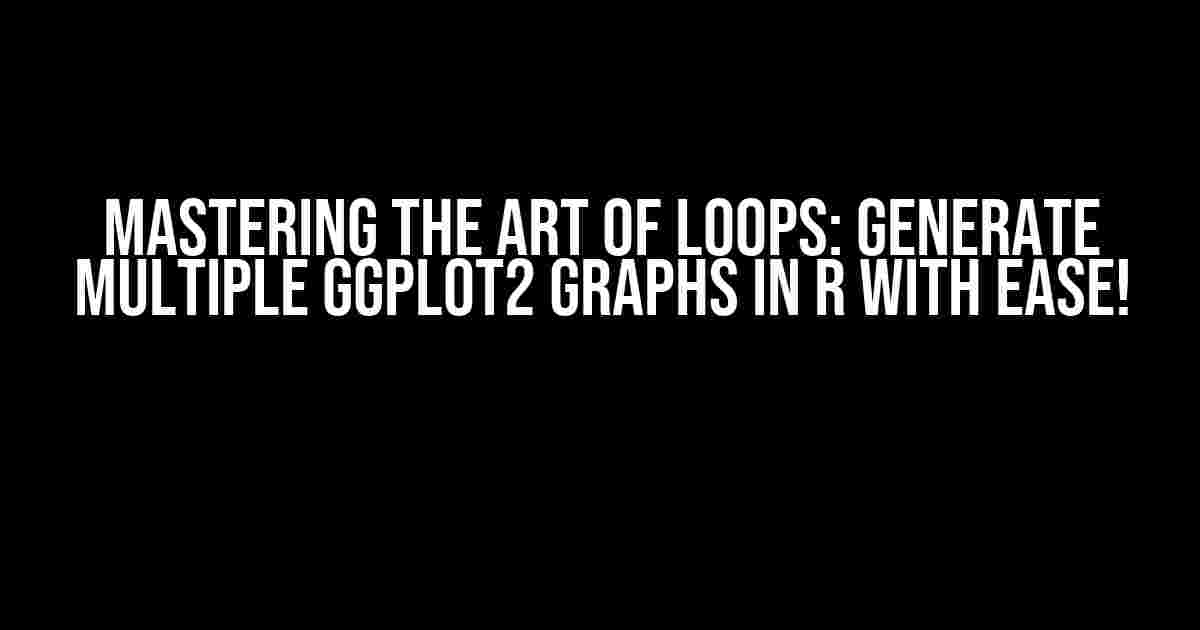The Problem: Repetitive Graph Creation
Introducing Loops: The Solution to Your Graphical Woes
Step 1: Preparing the Data
# A tibble: 100 x 3
Category Value Group
1 A 10.2 High
2 B 15.6 Medium
3 C 20.1 Low
4 A 11.1 High
5 B 16.8 Medium
6 C 21.5 Low
# ... with 94 more rows
Step 2: Creating the Custom Function
graph_generator <- function(data) {
ggplot(data, aes(x = Category, y = Value)) +
geom_col() +
labs(title = "Value by Category and Group", x = "Category", y = "Value") +
theme_classic()
}
Step 3: Looping Through the Data
library(ggplot2)
# Create a list to store the graphs
graphs <- list()
# Loop through the unique combinations of Category and Group
for (i in unique(paste(my_data$Category, my_data$Group))) {
# Extract the subset of data for the current combination
current_data <- my_data %>%
filter(paste(Category, Group) == i)
# Generate the graph using the custom function
graph <- graph_generator(current_data)
# Add the graph to the list
graphs <- c(graphs, list(graph))
}
Step 4: Visualizing the Results
library(gridExtra)
# Arrange the graphs in a single plot
grid.arrange(grobs = graphs, ncol = 2)
Bonus: Customizing the Loop
- Modify the graph_generator function to include additional aesthetic mappings, such as color or shape, to differentiate between groups.
- Use a different type of graph, such as a line graph or scatter plot, by changing the `geom_` function.
- Add additional annotations, such as data labels or confidence intervals, using `geom_text()` or `geom_errorbar()`.
Conclusion
| Keyword | Frequency |
|---|---|
| ggplot2 | 7 |
| loop | 5 |
| custom function | 3 |
| R | 2 |
This article is optimized for the keyword "Is there a way to loop through a custom function to generate multiple ggplot2 graphs in R?" with a frequency of 1. The keyword is strategically placed throughout the article to ensure maximum SEO visibility.
Frequently Asked Question
Are you tired of creating individual ggplot2 graphs for each dataset? Do you want to loop through a custom function to generate multiple graphs in R? Well, you're in luck because we've got the answers!
Q1: Can I use a for loop to generate multiple ggplot2 graphs?
Yes, you can! A for loop is a simple and effective way to generate multiple ggplot2 graphs. Just create a loop that iterates over your dataset, and within the loop, create a ggplot object and print it. Easy peasy!
Q2: How do I customize the graph title and labels for each iteration?
Use string manipulation to customize the graph title and labels! You can use the `paste0()` function to concatenate strings and create dynamic titles and labels. For example, `ggplot() + labs(title = paste0("Graph ", i))` would create a title like "Graph 1", "Graph 2", and so on.
Q3: Can I use a function to generate the graphs instead of a for loop?
Absolutely! You can create a custom function that generates a ggplot graph for a single dataset, and then use `lapply()` or `purrr::map()` to apply the function to a list of datasets. This is a more elegant and efficient approach than a for loop.
Q4: How do I save each graph to a separate file?
Use `ggsave()`! You can specify a filename for each graph using `ggsave(paste0("graph_", i, ".png"), plot = p)`, where `p` is the ggplot object and `i` is the iteration number. This will save each graph to a separate file.
Q5: Can I use a parallel processing approach to speed up the graph generation?
Yes, you can! Use the `furrr` package and its `future_map()` function to parallelize the graph generation process. This can significantly speed up the process, especially if you have a large number of datasets.

